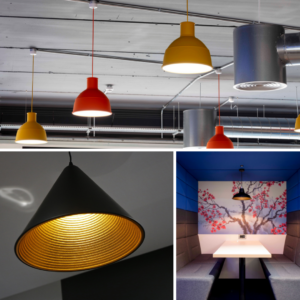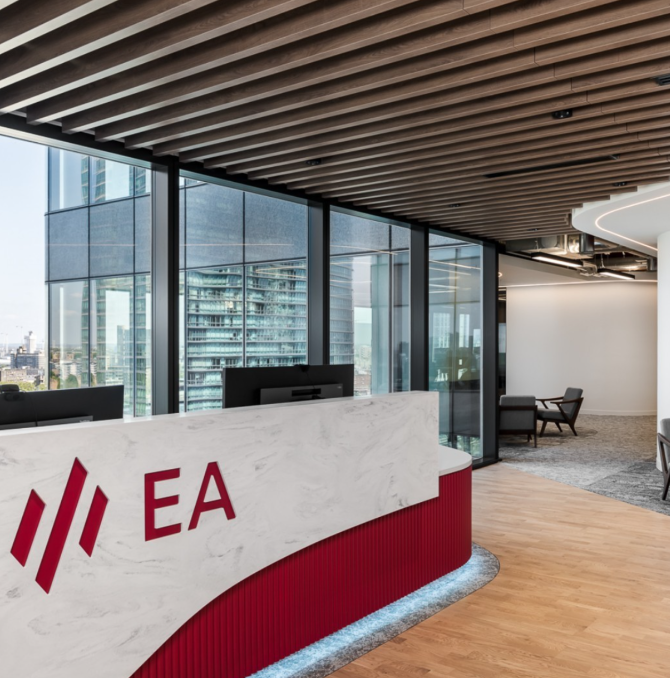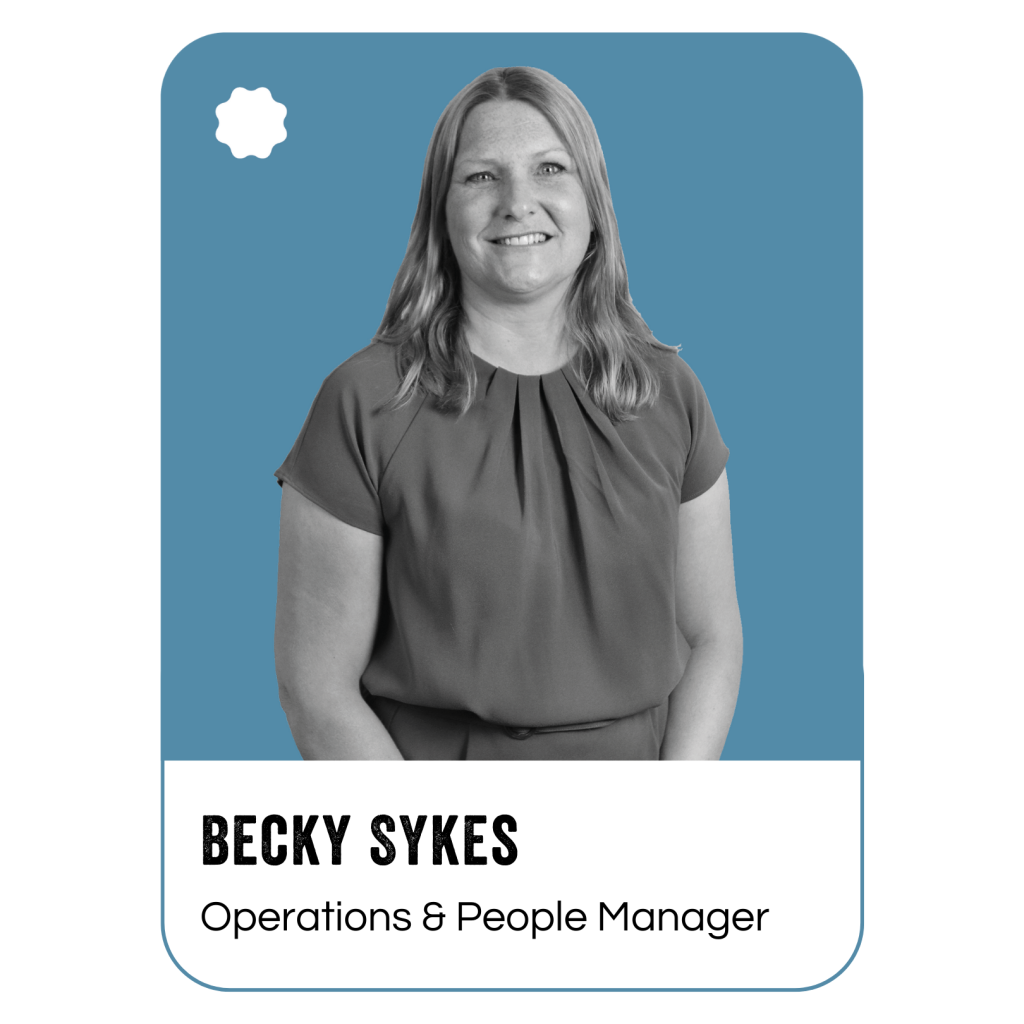
Light It Up
Lighting has a profound effect on how we function in our daily lives. Put simply, the more light we have the more productive we feel. When light is restricted, we begin to feel more tired and less engaged.
Shining a Light on Productivity
It’s no secret that workplaces are changing for the better. Modern workspaces should be positive, but what do we mean by this and why is it important? The space should revolve around the needs of the staff and enable them to work to their best ability. A study by Leesman reported that 77% of the people they interviewed said natural light is important to them, yet only 58% were satisfied with their workplaces’ offering.[1]
We’ve always believed that light is one of the most important factors when planning a workplace fit-out. And we’re not the only ones. Health & Safety England state that poor lighting can affect our health at work, from eyestrain to migraines. Worse yet, Sick Building Syndrome is linked to many new and refurbished buildings which do not factor in good lighting. Symptoms of SBS include headaches, lethargy, irritability, and poor concentration.[2]

A quick way to resolve this? Well-considered lighting and use of natural daylight. Natural light alone reduces the effects of Seasonal Affective Disorder, increases visual clarity and colour perception, boosts Vitamin D absorption, increases mental awareness and mood, and stimulates the Pineal Gland helping to regulate sleep patterns.[3]
Built-in lighting is just as important. Lighting control systems that allow employees to change the level of light create a healthy work environment that promotes engagement, well-being, and productivity.[4]
The Science of Office Lighting: Where and Why?
Our Creative Director Scott Colman explains, “when considering lighting in workplace fit-outs, we always advise our clients to start with considering the office layout. By u nderstanding how the space will be utilised, we’ll be able to use the best combination of natural and built-in lighting to create a productive and positive workplace.”
nderstanding how the space will be utilised, we’ll be able to use the best combination of natural and built-in lighting to create a productive and positive workplace.”
Where possible an open-plan office, should create spaces where natural light is let in. Fighting for the desk by the win
dow should be a thing of the past.
Whether synthetic or natural, your lighting should reflect the circadian rhythm. How best can you achieve this? By creating a mixture of different lighting [5]. A mixture of high illumination with low-level levels and different angles of light direction creates a positive workplace.
Science tells us that a mixture of light sources and illumination levels will ensure productivity by syncing in with your employee’s natural circadian rhythm. So much so, it can increase productivity by up to 40% and creativity by 15%.[6]
Lighting Trends: What Your Workplace Needs
We caught up with our Lead Designer Heidi to find out which trends are shining a new light on office spaces and what benefits she thinks they’ll bring to a positive workplace:
1. Productive Break-out Spaces
Lifestyle product design giants Philips[7] suggest that one of the key trends of lighting in the positive workplace is a well-lit breakout space. They believe that good quality light, glare control, and the ability to dim the area when it’s required can create a contrasting space to the rest of your workplace.
The benefit? “Break-out spaces should be a spot to rejuvenate and inspire, where relaxation allows for a new wave of productivity.[8] A well-lit breakout space will give your team members a place to recharge.”
 2. LEDs That Light Up Your Workplace
2. LEDs That Light Up Your Workplace
LED lightbulbs have been shown to have a positive influence on our energy, mood, vitality, and work performance. Better yet, LED lighting reduces your energy usage and costs by 80%.
The benefit?
Or shall I say benefits? LED lighting is good for the planet and good for your employees!
3. Bright & Warm
When it comes to keeping up with the circadian rhythm, it’s important to maintain bright and warm lights in the workplace.
The benefit?
“Maintaining bright lighting will assist in the avoidance of the disruption of daylight savings. [9] It’s really important to create a comforting atmosphere in the darker winter days, and bright and warm lighting does just that.”
One of the negative effects of a reduced amount of light in our lives is that we’re less productive. A productive office requires plenty of natural light to keep team members working at their best. But how can this be achieved?
The Future of Lighting and Productivity
We’re finding that more of our clients are listing an increase in productivity as one of their key requirements when starting a workplace fit-out. As champions of the Positive Workplace, we spend a lot of our time investing in the latest and most innovative lighting products and design concepts.
We expect lighting requirements will develop with the changing workplace. Requests from modern workers for modern workplaces will see the benefit in levels of lighting. The use of LED light bulbs and levels of lighting will create productive spaces that complement the needs of employees. Satisfied employees will find the best spaces to work in, making them more productive than ever. All thanks to shining the right light in the right space.
Want to create your own positive workplace?
We have 20 years of experience designing workplaces that go beyond a lick of paint. As leaders in creating positive workplaces, we invest in research and innovation, so you don’t have to.
Want to find out how we can improve in your workplace? Get in touch.
[1] https://www.hrreview.co.uk/hr-news/strategy-news/david-willetts-role-daylight-employee-engagement/103521
[2] https://www.hse.gov.uk/pubnS/priced/hsg38.pdf
[3] https://www.hrreview.co.uk/hr-news/strategy-news/david-willetts-role-daylight-employee-engagement/103521
[4] Lighting, Well-being and Performance at Work, City University London: https://www.cass.city.ac.uk/__data/assets/pdf_file/0004/363217/lighting-work-performance-cass.pdf
[5] https://luxreview.com/article/2016/04/6-lighting-hacks-for-healthier-more-productive-workplaces
[6] https://www.eco-business.com/opinion/why-natural-light-matters-in-the-workplace/
[7] http://images.philips.com/is/content/PhilipsConsumer/PDFDownloads/Global/ODLI20150821_002-UPD-en_AA-office-application-guide-INT.pdf
[8] https://ukenergylighting.co.uk/benefits-of-led-lighting-in-offices/









